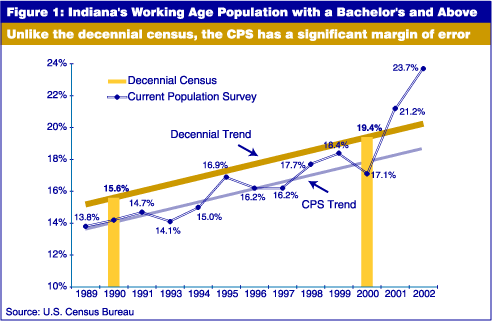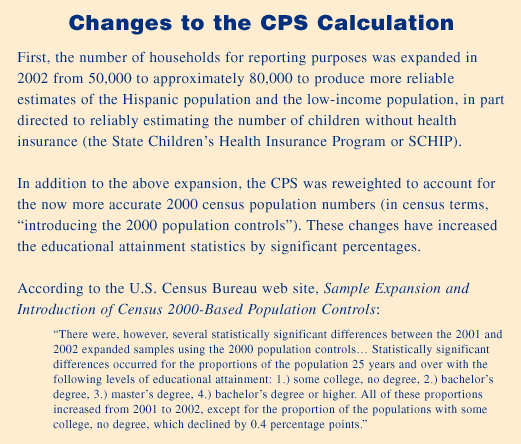Indiana's Educational Attainment: Real Progress or Illusion?
Indiana's progress in retaining individuals with college degrees within its workforce jumped dramatically over the past two years, according to an Indianapolis Star article on March 21, 2003. State policymakers starved for good news about the Hoosier state were understandably delighted. Policy analysts familiar with the relevant statistics were more wary, and reasonably so.
Educational attainment is defined as the percentage of a state or region's population holding a specific degree or set of degrees. In the recent past, the most quoted educational attainment statistic is the proportion of people of working age with a bachelor's degree or more. The U.S. Census Bureau defines the working age population as age 25 and above and measures this ratio:
- In the decennial census
- In a somewhat new annual survey called the American Community Survey (ACS)
- In the March version of the annual Current Population Survey (CPS).
It was the March 2002 results from the Current Population Survey that prompted the Star's article.
The old adage, "If it sounds too good to be true, it probably is," holds for statistical miracles even more solidly than for other kinds of phenomena. Few things change rapidly in a state's demographic profile vis-à-vis other states. The reason is that the numbers of people are very large, and the forces acting on one state are usually acting on all states concurrently.
The Decennial Census
Figure 1 shows the proportion of Indiana's population age 25 and above with bachelor's degree or more. Using the decennial census, Indiana increased from 15.6 percent in 1990 to 19.4 percent in the 2000 census. This increase was in itself a substantial improvement. Although all states increased in this statistic during the decade, Indiana's rate of change was the 12th greatest. In fact, only eight other states increased in rank more than Indiana did from 1990 to 2000. Indiana went from 46th in 1990 (for all states and the District of Columbia) to 44th in 2000.

The decennial census numbers are the most helpful yardstick for this measure of a state's educational attainment because there is essentially no margin for error on a state level measurement. The decennial census (long-form) counts approximately one in six households, which works out to more than 360,000 in Indiana. As a result, we can be confident that for both Indiana and the other states being measured against us, the percentages are accurate and the rankings are valid.
The Current Population Survey
The CPS is much different in design and purpose from the decennial census. The CPS is a monthly survey, designed to yield labor force data on a national basis using a highly stratified (754 strata) sampling process. The annual March CPS is an enhanced survey designed to produce some specific broader population estimates.
In the past two years, there have been a few changes to the CPS, which may affect its accuracy in measuring educational attainment (see inset). According to census staff, these changes also "bumped" the entire U.S. population upward by about 3.5 million people.

The CPS measurement of educational attainment increased for Indiana from 17.1 percent in 2000 to 23.7 percent in 2002. This was a 38.6 percent increase, the largest in the nation. Delaware was the next closest state, increasing from 24 percent in 2000 to 29.5 percent in 2002.
Unlike the decennial census measure, the CPS has a significant margin of error. A sample survey like the CPS exhibits two types of error—sampling error and non-sampling error.
Sampling error is related to the design of the survey and could be affected by the changes in the CPS that have taken place in the last two years. The error rates and resulting confidence interval calculations make state-to-state comparisons even more problematic. When standard errors are not taken into account, Indiana's 23.7 percent statistic in 2002 for the proportion of the population with bachelor's degrees and above ranks the state 34th among the 50 states and D.C. If standard errors are used, then there is no significant difference in rank between Indiana and 16 other states. This should make policy analysts cautious when using the CPS as an indicator of miraculous progress in educational attainment.
The American Community Survey
There is one other measure, an annual one, that collects data on educational attainment. The American Community Survey samples approximately 700,000 households across the nation. It has exhibited statistics closer to those of the decennial census when measuring educational attainment. The 2002 results for the ACS should be available in July of this year. Until that time, Indiana's progress on educational attainment should be discussed in relation to the decennial census ranking, where we have demonstrated good, but not miraculous, advancement compared with our neighbors (see Table 1). Miracles belong to another realm outside of public policy. Indiana policymakers need to remember that our progress will only continue if the requisite leadership and investment continue apace.

Bill Sheldrake
Senior Vice President for Research and Policy Analysis,
Thomas P. Miller and Associates
